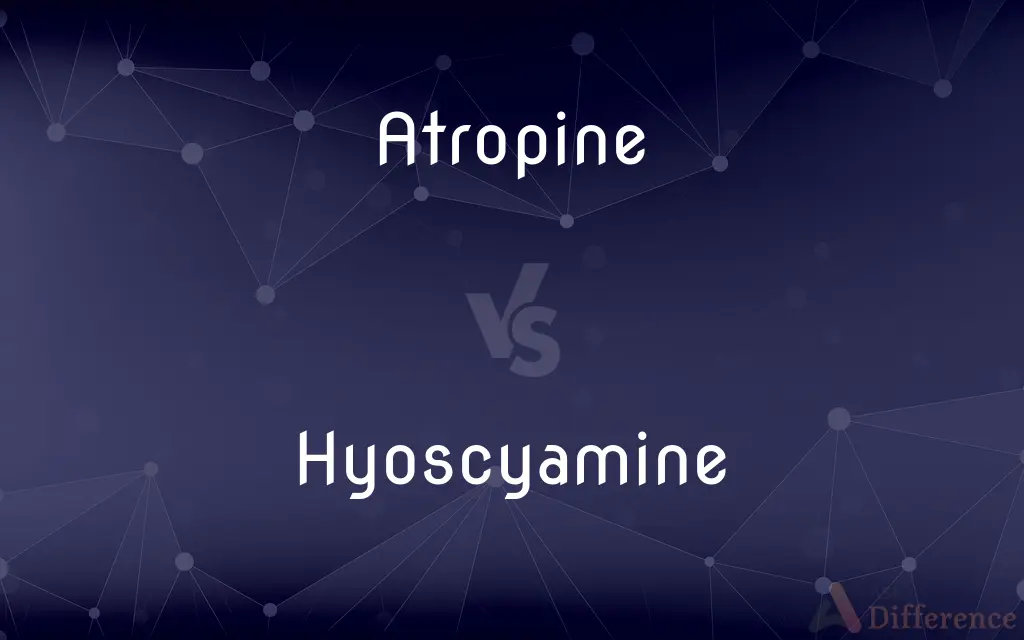Atropine vs. Hyoscyamine — What's the Difference?
By Fiza Rafique & Urooj Arif — Updated on April 4, 2024
Atropine is a medication used for various medical conditions, including bradycardia and poisoning, while hyoscyamine is primarily used for gastrointestinal disorders. Both derive from nightshade plants and have anticholinergic effects.

Difference Between Atropine and Hyoscyamine
Table of Contents
ADVERTISEMENT
Key Differences
Atropine is a versatile drug used in emergency medicine to treat bradycardia (slow heart rate) and as an antidote for organophosphate poisoning. It works by blocking acetylcholine in the central and peripheral nervous system, thereby increasing heart rate and reducing secretions. Hyoscyamine, on the other hand, is more focused on treating gastrointestinal disorders such as irritable bowel syndrome and spasticity by relaxing smooth muscles and reducing fluid secretions in the GI tract.
Both atropine and hyoscyamine are anticholinergic agents, meaning they inhibit the action of the neurotransmitter acetylcholine. This inhibition is beneficial in various therapeutic contexts, such as pre-operative preparation to reduce saliva and other secretions. While atropine has a broad range of applications due to its systemic effects, hyoscyamine is used more specifically to target the gastrointestinal system and related conditions.
Atropine is known for its role in ophthalmology, where it is used to dilate pupils during eye examinations, allowing for a better view of the retina and other internal structures. Hyoscyamine, while it also has anticholinergic properties, is not typically used in this capacity, focusing instead on its ability to alleviate abdominal pain and spasms.
In terms of administration, atropine can be given intravenously, orally, or as eye drops, depending on its intended use. Hyoscyamine is also available in various forms, including tablets and liquid, tailored to its role in treating gastrointestinal issues. The versatility in administration methods for both drugs underscores their adaptability to different clinical scenarios.
Despite their shared anticholinergic properties, the specific indications and side effect profiles of atropine and hyoscyamine guide their use in medical practice. For instance, the side effects of atropine, such as dry mouth, blurred vision, and tachycardia, are closely monitored, especially in emergency settings. Hyoscyamine, while also presenting risks of dry mouth and vision issues, is dosed carefully to minimize these effects, particularly given its use in a more chronic setting for GI conditions.
ADVERTISEMENT
Comparison Chart
Primary Use
Bradycardia, organophosphate poisoning
Gastrointestinal disorders
Mechanism
Anticholinergic, increases heart rate
Anticholinergic, relaxes smooth muscles
Application Range
Emergency medicine, ophthalmology
Gastrointestinal specificity
Administration
IV, oral, eye drops
Tablets, liquid
Side Effects
Dry mouth, blurred vision, tachycardia
Dry mouth, blurred vision
Compare with Definitions
Atropine
A medication used to treat slow heart rate and as an antidote for poisoning.
Atropine was administered to counteract the bradycardia.
Hyoscyamine
Primarily used for gastrointestinal disorders.
Hyoscyamine was prescribed for her irritable bowel syndrome.
Atropine
Has anticholinergic properties, blocking acetylcholine.
Atropine's anticholinergic effect is vital in pre-operative preparation.
Hyoscyamine
Also has anticholinergic effects, similar to atropine.
The anticholinergic properties of hyoscyamine help in reducing fluid secretions.
Atropine
Used in ophthalmology to dilate pupils.
The doctor used atropine drops for the eye exam.
Hyoscyamine
Relaxes smooth muscles in the GI tract.
Hyoscyamine effectively reduced his abdominal spasms.
Atropine
Can cause side effects like dry mouth and blurred vision.
After receiving atropine, the patient reported dry mouth.
Hyoscyamine
Available in tablets and liquid form.
She took hyoscyamine tablets before meals to manage symptoms.
Atropine
Administered via IV, orally, or as eye drops.
Atropine can be given orally before surgery to reduce secretions.
Hyoscyamine
Side effects include dry mouth and blurred vision.
He experienced dry mouth as a side effect of hyoscyamine.
Atropine
Atropine is a tropane alkaloid and anticholinergic medication used to treat certain types of nerve agent and pesticide poisonings as well as some types of slow heart rate, and to decrease saliva production during surgery. It is typically given intravenously or by injection into a muscle.
Hyoscyamine
Hyoscyamine (also known as daturine or duboisine) is a naturally occurring tropane alkaloid and plant toxin. It is a secondary metabolite found in certain plants of the family Solanaceae, including henbane (Hyoscyamus niger), mandrake (Mandragora officinarum), angel's trumpets (Brugmansia spp.), jimsonweed (Datura stramonium), tomato (Solanum lycopersicum), the sorcerers' tree (Latua pubiflora), and deadly nightshade (Atropa belladonna).
Atropine
A poisonous, bitter, crystalline alkaloid, C17H23NO3, obtained from belladonna and other related plants. It is used to dilate the pupils of the eyes and as an antispasmodic.
Hyoscyamine
A poisonous white crystalline alkaloid, C17H23NO3, isometric with atropine and having similar uses but more potent effects.
Atropine
An alkaloid extracted from the plant deadly nightshade (Atropa belladonna) and other sources, such as the seeds of the thorn-apple. Though overdoses would be fatal it is used as a drug in medicine for its paralytic effects (e.g. in surgery to relax muscles, in dentistry to dry the mouth, in ophthalmology to dilate the pupils).
Hyoscyamine
A poisonous alkaloid present in henbane that is the stereoisomer of atropine, with similar properties to hyoscine, and used medicinally to treat abdominal pain and similar conditions.
Atropine
A poisonous, white, crystallizable alkaloid, extracted from the Atropa belladonna, or deadly nightshade, and the Datura Stramonium, or thorn apple. It is remarkable for its power in dilating the pupil of the eye. Called also daturine.
Hyoscyamine
An alkaloid found in henbane (Hyoscyamus niger), and regarded as its active principle. It is also found with other alkaloids in the thorn apple and deadly nightshade. It is extracted as a white crystalline substance, with a sharp, offensive taste. Hyoscyamine is isomeric with atropine, is very poisonous, and is used as a medicine for neuralgia, like belladonna. Called also hyoscyamia, duboisine, etc.
Atropine
A poisonous crystalline alkaloid extracted from the nightshade family; used as an antispasmodic and to dilate the eye pupil; also administered in large amounts as an antidote for organophosphate nerve agents or organophosphate insecticides
Hyoscyamine
A poisonous crystalline alkaloid (isometric with atropine but more potent); used to treat excess motility of the gastrointestinal tract
Common Curiosities
How do atropine and hyoscyamine differ in their medical applications?
Atropine has a broader range of applications, including emergency medicine and ophthalmology, while hyoscyamine is focused on gastrointestinal issues.
What are the common side effects of anticholinergic drugs?
Common side effects include dry mouth, blurred vision, constipation, and in some cases, increased heart rate.
Is atropine safe for everyone?
Atropine should be used cautiously, especially in the elderly and those with certain heart conditions, due to its potential for causing tachycardia and other side effects.
Can these drugs affect vision?
Yes, both drugs can cause blurred vision as a side effect due to their anticholinergic action, which affects the eye's ability to focus.
Are there any dietary restrictions while taking hyoscyamine?
While there are no specific dietary restrictions, it's important to follow medical advice regarding meal timing and the consumption of certain foods that might exacerbate GI symptoms.
Can atropine and hyoscyamine be used interchangeably?
While they share anticholinergic properties, their specific clinical uses based on their effect profiles make them suitable for different conditions.
What should be considered when taking hyoscyamine for GI disorders?
The timing of doses relative to meals and the potential interaction with other medications should be carefully managed.
How do atropine and hyoscyamine affect heart rate?
Atropine can increase heart rate by blocking acetylcholine, which is used strategically in cases of bradycardia. Hyoscyamine's primary action does not directly target heart rate but may have indirect effects due to its anticholinergic nature.
Why are atropine and hyoscyamine considered anticholinergic?
They block the action of acetylcholine, a neurotransmitter involved in muscle movements and secretions, characteristic of anticholinergic drugs.
What precautions should be taken when using these medications?
Patients should be aware of the side effects, avoid activities requiring clear vision or rapid response times if affected, and consult with healthcare providers about any existing health conditions that may influence the drug's safety.
Share Your Discovery

Previous Comparison
Pylon vs. Stanchion
Next Comparison
Blaster vs. PlasterAuthor Spotlight
Written by
Fiza RafiqueFiza Rafique is a skilled content writer at AskDifference.com, where she meticulously refines and enhances written pieces. Drawing from her vast editorial expertise, Fiza ensures clarity, accuracy, and precision in every article. Passionate about language, she continually seeks to elevate the quality of content for readers worldwide.
Co-written by
Urooj ArifUrooj is a skilled content writer at Ask Difference, known for her exceptional ability to simplify complex topics into engaging and informative content. With a passion for research and a flair for clear, concise writing, she consistently delivers articles that resonate with our diverse audience.














































